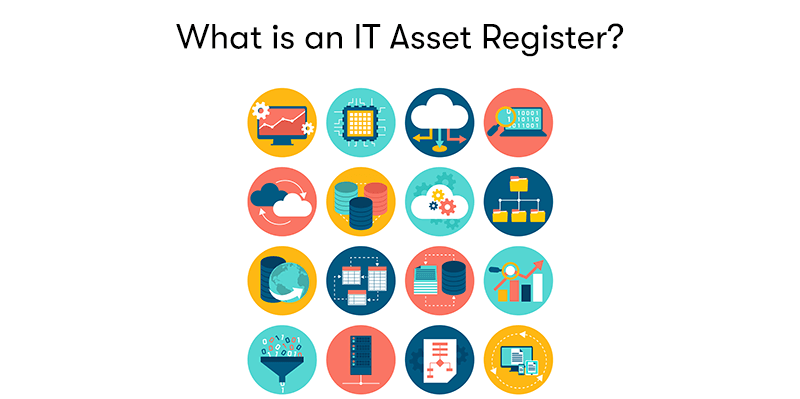What is an IT Asset Register?
Welcome to our in-depth exploration of the IT Asset Register, a cornerstone in the realm of Information Technology Asset Management (ITAM). In today's digitally-driven business landscape, the effective management of IT assets is not just a necessity but a strategic imperative.
An IT Asset Register is a comprehensive and structured repository that meticulously catalogues an organisation's technological tools and resources. This register encompasses a detailed inventory of all IT assets, from hardware components like servers and computers to software licenses and cloud-based services.
This article will delve into what constitutes an IT Asset Register, its significance in the modern business environment, and how it forms the backbone of efficient IT asset management, ensuring optimal utilisation and strategic alignment of technological resources with business goals.
What is an IT Asset Register?
An IT Asset Register, also known as an IT Asset Inventory or IT Asset Log, is a comprehensive record which organisations use to track their information technology (IT) assets. This record typically includes various IT equipment and software types, such as computers, servers, networking devices, software licenses, and other technology-related items.
An IT Asset Register is crucial for effective IT asset management (ITAM). It helps organisations track and manage their IT assets throughout their lifecycle, ensure software license compliance, plan upgrades or replacements, manage risks, and make informed decisions about IT investments. It also plays a critical role in security management by helping to ensure that all assets are accounted for and properly maintained.
Why is a Register of IT Assets Important?
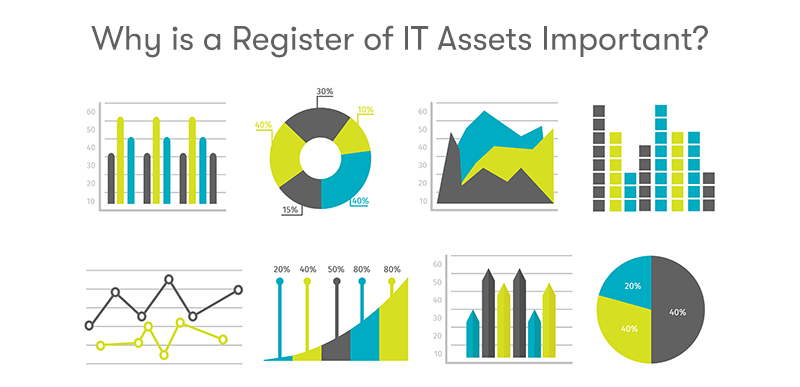
A Register of IT Assets is essential for several reasons, each contributing to an organisation's effective management and strategic planning. Here are the key reasons why maintaining an IT Asset Register is crucial:
Asset Tracking and Management
It enables organisations to keep track of all IT assets, ensuring that they are efficiently utilised and adequately maintained. This is particularly important in larger organisations where the sheer volume of assets can be challenging to manage without a centralised record.
Financial Management
An IT Asset Register helps in financial planning and budgeting. It provides a clear overview of the assets' value, aids in depreciation calculations, and helps make informed decisions about future investments or cost-saving measures.
Compliance and Audit Readiness
Many industries have regulations concerning the management and usage of IT assets, especially those holding sensitive data. An IT Asset Register helps maintain compliance with these regulations and simplifies the audit process by providing necessary documentation and records.
Risk Management
By knowing your assets and where they are, you can better assess and manage theft, loss, or damage risks. This also includes managing cybersecurity risks by ensuring all assets are accounted for and updated with the latest security patches.
License and Contract Management
Software assets help in managing licenses and avoiding legal issues related to under-licensing or piracy. It also aids in managing service contracts and renewals efficiently.
Support and Maintenance
An IT Asset Register helps track the maintenance history and support requirements of assets. This facilitates timely maintenance and support activities, reducing downtime and increasing the longevity of assets.
Strategic Planning
It provides valuable insights for strategic IT planning, including replacement and upgrade cycles. This helps make data-driven decisions about allocating resources for maximum impact.
Disaster Recovery
In the event of a disaster, having a detailed record of IT assets is invaluable for recovery efforts. It helps in quickly identifying what needs to be replaced or restored.
In summary, an IT Asset Register is not just a record-keeping tool but a strategic asset that aids in multiple facets of IT management, financial planning, compliance, risk management, and strategic decision-making.
What Needs to be Included in Your Asset Register?
When creating an IT Asset Register, it's essential to include comprehensive and detailed information for each asset to ensure effective management and tracking. Here are the key elements that should be included in your IT Asset Register:
- Asset Identification: Each asset should have a unique identifier, such as a serial number or asset tag number. This helps in easily tracking and identifying each asset.
- Description of the Asset: Include a detailed description of the asset, such as the type of equipment (e.g., laptop, server, router), brand, model, and specifications (e.g., processor type, RAM, storage capacity).
- Location: Record where each asset is located. This can be as specific as a room number in a building or a geographical location for remote assets.
- Purchase Details: Include information about the purchase, such as the purchase date, price, vendor, and purchase order number. This information is crucial for financial tracking and depreciation calculations.
- Ownership and Custodianship: Document who is responsible for the asset. This might be an individual, a department, or a team.
- Status: Note the current status of the asset, such as in use, in repair, in storage, or retired.
- Warranty and Service Information: Include warranty details, such as the warranty period and terms. Also, note any service agreements or maintenance schedules associated with the asset.
- Software Licenses: For software assets, include information about the license type, number of licenses, purchase details, expiration date, and usage terms.
- Configuration Details: For more complex assets, include configuration details such as software versions, installed updates, and network settings.
- Maintenance and Repair History: Keep a log of any maintenance, repairs, upgrades, or other changes made to the asset.
- Depreciation and Valuation: Include financial information like the original cost, current value, and depreciation schedule to help in accounting and financial planning.
- Disposal Information: When an asset is retired or disposed of, record the details of its disposition, including the date of disposal and method (e.g., recycled, sold, donated).
- Supporting Documentation: Attach or reference any supporting documents, such as purchase receipts, warranty cards, user manuals, and service agreements.
Each organisation may have specific needs and regulatory requirements, so the Asset Register should be tailored accordingly. Regular updates and audits of the Asset Register are essential to ensure its accuracy and usefulness in effectively managing IT assets.
What Are IT Assets?
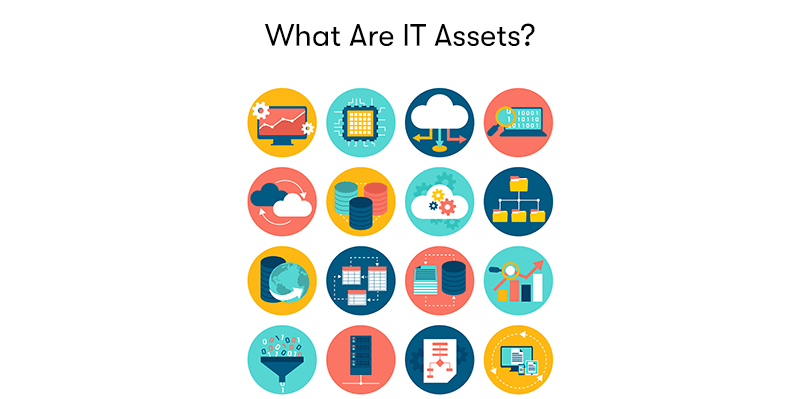
IT assets are the components of hardware, software, and related infrastructure that are part of an organisation's technology environment. These assets play a critical role in the daily operations and strategic initiatives of businesses and institutions. Here's a breakdown of the different types of IT assets:
Hardware Assets
Computers: This includes desktops, laptops, workstations, and tablets.
Servers: These are critical for hosting applications, storing data, and managing network operations.
Networking Equipment: Routers, switches, firewalls, and other devices that facilitate network connectivity and security.
Printers and Scanners: Devices used for printing and scanning documents.
Mobile Devices: Smartphones and other mobile technology used for business purposes.
Peripheral Devices: Keyboards, mice, monitors, and other accessories.
Data Storage Devices: External hard drives, NAS (Network-Attached Storage) devices, and backup systems.
Audio-Visual Equipment: Projectors, microphones, and other AV equipment used in business settings.
Software Assets
Operating Systems: Software that manages computer hardware and provides common services for computer programs.
Application Software: Programs that perform specific tasks for users, such as office productivity suites, customer relationship management (CRM) systems, and graphic design tools.
Enterprise Resource Planning (ERP) Systems: Integrated software platforms used to manage and integrate core business processes.
Databases and Management Software: Systems that store, retrieve, and manage data.
Security Software: Antivirus, anti-malware, and cybersecurity tools.
Development Tools: Software used for programming and software development.
Cloud-Based Assets
Software-as-a-Service (SaaS) Applications: Cloud-based applications accessed via the internet.
Infrastructure-as-a-Service (IaaS): Online services that provide high-level APIs used for dereferencing various low-level details of underlying network infrastructure.
Platform-as-a-Service (PaaS): Cloud platform services provide a framework for developers to build upon and create customised applications.
Telecommunications Assets
Phone Systems: Landlines, VoIP systems, and PBX (Private Branch Exchange) systems.
Communication Devices: Modems, wireless access points, and other devices that facilitate telecommunications.
Intangible IT Assets
Licenses and Intellectual Property: Software licenses, patents, and copyrights.
Data and Information: Business data, customer information, proprietary research, and analytics.
Each of these assets requires proper management, including procurement, maintenance, updates, and eventual decommissioning or replacement. The diversity and complexity of IT assets make it imperative for organisations to have effective IT asset management practices in place.
How Can You Build an IT Asset Register?
Building an IT Asset Register is a systematic process that involves several steps. Here's a guide on how to create an effective IT Asset Register for your organisation:
Define the Scope
Determine which types of assets will be included in the register. This typically includes hardware, software, and possibly cloud-based assets.
Decide on the level of detail required for each asset. For example, you might need model numbers, specifications, and physical location for hardware.
Develop a Standardised Format
Choose a format for the asset register that is easy to update and manage. This could be a spreadsheet, a database, or specialised asset management software.
Define the fields that will be included for each asset, such as asset ID, description, location, purchase details, status, and any other relevant information.
Gather Existing Data
Collect information from various sources such as invoices, purchase orders, warranty documents, and existing inventories.
If you're using IT asset management software, it might offer discovery tools to detect and list hardware and software assets automatically.
Assign Unique Identifiers
Assign a unique identifier or asset tag to each asset. This can be a serial number, barcode, or RFID tag.
Physically Verify and Catalogue Assets
Conduct a physical audit to verify the existence and condition of each asset.
Record all relevant details in the asset register as per the defined fields.
Include Financial Information
Add financial details such as purchase price, depreciation, current value, and expected lifespan.
Document Ownership and Responsibility
Record who is responsible for each asset. This could be an individual, a department, or a team.
Set Up Processes for Updating the Register
Establish procedures for regularly updating the asset register. This includes when new assets are acquired, when assets are disposed of, and when there are changes in location or status.
Determine who will be responsible for these updates.
Implement Security and Access Controls
Ensure that sensitive information in the asset register is secure.
Control access to the register, allowing only authorised personnel to make changes.
Integrate with Other Systems
If possible, integrate the asset register with other systems like procurement, finance, or helpdesk software for streamlined operations.
Regular Reviews and Audits
Schedule regular audits to ensure the accuracy of the register.
Review and update the asset management processes as needed.
Training and Communication
Train relevant staff on how to use and maintain the asset register.
Communicate the importance of accurate asset tracking and management to all stakeholders.
Remember, an IT Asset Register is a living document that requires regular updates and maintenance to remain effective. The initial setup might require considerable effort, but the long-term benefits of asset management, financial planning, and operational efficiency are significant.
Can You Use Software for Your Register?
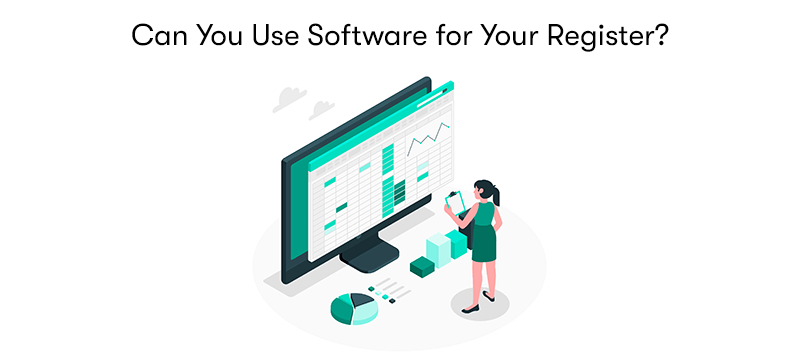
Yes, using software for your IT Asset Register is not only feasible but highly recommended, especially for medium to large organisations or those with complex IT environments. Various software solutions are available that can facilitate the management of IT assets more efficiently and accurately than manual methods like spreadsheets. Here are the key benefits of using software for your IT Asset Register:
Automated Asset Discovery
Many IT asset management software solutions offer automated discovery features that scan your network to identify and log hardware and software assets. This reduces the manual workload and increases accuracy.
Centralised Management
Software provides a centralised platform for managing all your IT assets, making updating, tracking, and retrieving asset information easier.
Real-time Tracking and Updates
With software, you can get real-time updates on the status and condition of your assets. This is particularly useful for tracking software licenses, warranty expirations, and maintenance schedules.
Reporting and Analytics
Asset management software often includes reporting tools that enable you to analyse the data for better decision-making. This can consist of financial reports for depreciation, usage reports for performance analysis, and more.
Integration Capabilities
Many asset management tools can integrate with other systems like procurement, finance, and helpdesk software. This integration facilitates seamless workflow and data consistency across different business functions.
Scalability
Software solutions can easily scale with your business, accommodating an increasing number of assets without significant changes in the management process.
Enhanced Security
Software solutions offer better security features to protect sensitive data in your asset register, such as user access controls, encryption, and audit trails.
Customisation and Flexibility
Many software solutions offer customisation options to tailor the asset register to your specific needs and processes.
Efficient Auditing and Compliance
With software, auditing your IT assets becomes more straightforward, aiding in compliance with various regulatory requirements.
Accessibility and Collaboration
Cloud-based asset management software offers the advantage of accessibility from anywhere, facilitating collaboration among teams and departments.
When choosing software for your IT Asset Register, consider factors like the size of your organisation, the complexity of your IT infrastructure, integration needs with other systems, budget, and specific features relevant to your operations. Popular options range from simple inventory management tools to comprehensive IT asset management suites.
What Are Best Practices for Managing an Asset Register in IT?
Managing an IT Asset Register effectively involves adhering to best practices that ensure the register remains accurate, up-to-date, and useful for decision-making and strategic planning. Here are some best practices for managing an IT Asset Register:
Regular Audits and Updates
Conduct regular audits to ensure the accuracy of the register.
Update the register promptly when assets are acquired, disposed of, or their status changes (e.g., from in-use to under repair).
Standardisation of Processes
Establish standardised procedures for adding, modifying, and retiring assets from the register.
Use consistent naming conventions and categorisation for ease of understanding and management.
Detailed Asset Information
Include comprehensive details for each asset, including description, location, purchase date, cost, condition, and assigned user or department.
For software assets, track licenses, versions, and expiration dates.
Integration with Other Systems
Integrate the asset register with other business systems like procurement, finance, and service management for streamlined processes and data consistency.
Clear Ownership and Responsibility
Assign clear responsibility for asset management tasks, including maintaining the asset register.
Define who is responsible for each asset, ensuring accountability for its maintenance and usage.
Use of Asset Management Software
Utilise specialised asset management software to automate and simplify tracking and managing assets.
Accessibility and Security
Ensure the asset register is accessible to those who need it, but also secure it to prevent unauthorised access.
Implement role-based access controls to protect sensitive information.
Training and Communication
Train staff on the importance of asset management and how to use the asset register.
Communicate the role of the asset register in the organisation's operations and decision-making processes.
Documentation and Record Keeping
Keep thorough records, including documentation of purchases, warranties, service contracts, and disposal records.
Lifecycle Management
Monitor the entire lifecycle of each asset, from acquisition to disposal, to optimise usage and plan for replacements.
Financial Management
Track and manage the financial aspects of assets, such as purchase cost, depreciation, and residual value.
Plan for Disasters and Recovery
Include the asset register as part of your disaster recovery and business continuity planning.
Feedback and Continuous Improvement
Regularly seek feedback from users and stakeholders to improve the asset management process.
Stay updated with best practices and emerging trends in IT asset management.
By following these best practices, you can ensure that your IT Asset Register remains a valuable tool for managing your organisation's technology resources efficiently and effectively.
How Do IT Asset Registers Work in ITAM?
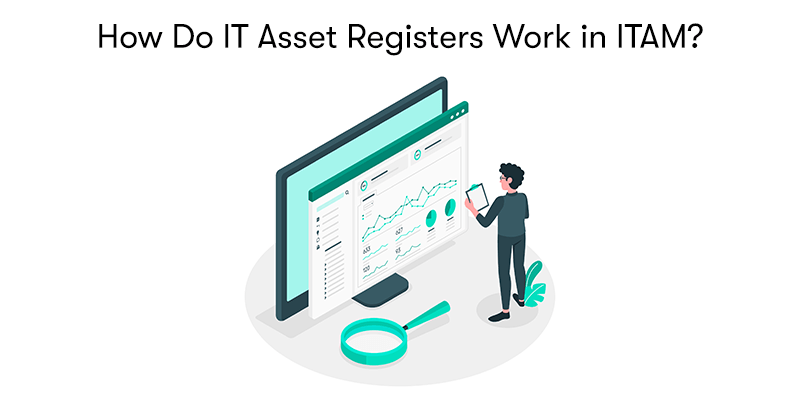
IT Asset Registers are pivotal in IT Asset Management, serving as the foundational tool around various ITAM processes. Here's how IT Asset Registers work within the framework of ITAM:
Central Repository of Asset Information
The IT Asset Register is a comprehensive database that stores detailed information about every IT asset in an organisation, including hardware, software, and sometimes cloud resources.
It is the central reference point for all asset-related data, crucial for decision-making and management processes.
Asset Lifecycle Management
ITAM involves managing assets throughout their entire lifecycle, from procurement to disposal. The asset register tracks each phase of this lifecycle, providing information on acquisition, deployment, maintenance, and decommissioning.
It helps in planning for asset replacements and upgrades by providing insights into asset age, condition, and performance.
Financial Management and Budgeting
The asset register includes financial data such as purchase cost, current value, and depreciation. This information is essential for budgeting, accounting, and calculating IT assets' total cost of ownership (TCO).
It aids in making informed decisions about IT investments and cost-saving opportunities.
Compliance and Audit Support
Organisations need to maintain accurate records of their IT assets to comply with regulatory standards and internal policies. The asset register provides this documentation.
During audits, the register serves as a verifiable record of the assets, their usage, and licensing, which is essential for software compliance and avoiding penalties.
Risk Management and Security
The IT Asset Register helps identify and manage risks associated with IT assets, such as security vulnerabilities, unsupported software, or hardware failures.
Organisations can ensure that all assets are accounted for, adequately secured, and updated with the latest security patches by having a detailed inventory of assets.
Operational Efficiency and Support
It streamlines operations by providing quick access to asset information, particularly useful for IT support and helpdesk teams.
It enables efficient management of resources, ensuring that assets are optimally utilised and not underused or over-allocated.
Strategic Planning and Reporting
The asset register aids in strategic IT planning by providing insights into the current state of IT infrastructure, future needs, and potential areas for improvement.
It can generate reports for stakeholders, offering visibility into the performance and health of the IT environment.
Integration with Other ITAM Processes
The asset register often integrates with other ITAM processes and tools, such as configuration management databases (CMDB), procurement systems, and service management platforms, for a holistic approach to IT management.
The IT Asset Register is a vital component of ITAM, providing the data foundation and insights necessary for effective management, strategic planning, compliance, risk mitigation, and operational support of IT assets.
Final Notes on Asset Registers
As we conclude our exploration into the world of IT Asset Management, we've delved into the intricacies of IT Asset Registers, understanding their definition, importance, and the comprehensive elements they must contain. We've also discussed how software can enhance the management of these registers, highlighting its automation and integration capabilities. Additionally, we've touched on best practices for maintaining an effective asset register, emphasising regular audits, standardised processes, and detailed asset information.
Finally, we explored the integral role of IT Asset Registers within ITAM, underscoring their contribution to lifecycle management, compliance, risk management, and strategic planning. This journey underscores the criticality of IT Asset Registers in navigating the complex landscape of IT infrastructure, ensuring efficiency, compliance, and informed decision-making in the ever-evolving digital age.


